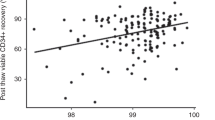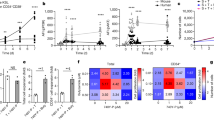Summary:
Dimethylsulfoxide (DMSO), which is widely used as a cryoprotectant for hematopoietic stem cells (HSC), has considerable toxicity for both the thawed cells and the patient. The aim of this study was to evaluate the cryoprotective potential of trehalose in comparison to DMSO for human HSC. Human bone marrow (BM) and peripheral blood stem cells (PBSC) of volunteer donors were cryopreserved in the presence of different concentrations of trehalose with and without insulin, as well as with DMSO 10%. After thawing to 37°C colony-forming unit (CFU) assays were performed. Long-term marrow-cultures (LTMC) were established and used for the detection of long-term culture-initiating cells (LTCIC). The total amount of CFUs detected was 104±134 (mean±s.d.) in DMSO-preserved cells and 179±34 in trehalose-protected cells. For LTMC the best feeder layer proved to be fresh human BM and the most useful concentration of trehalose was 0.5 M. Using these culture conditions we could detect after 5 weeks LTMC a total of 172±28 CFUs for trehalose-protected cells and 170±52 for DMSO-preserved cells. In conclusion, trehalose exerts a similar cryoprotective potential for hematopoietic progenitor and stem cells like DMSO and could possibly replace DMSO at least in part as cryoprotectant in the setting of hematopoietic cell transplantation.
This is a preview of subscription content, access via your institution
Access options
Subscribe to this journal
Receive 12 print issues and online access
$259.00 per year
only $21.58 per issue
Buy this article
- Purchase on Springer Link
- Instant access to full article PDF
Prices may be subject to local taxes which are calculated during checkout


Similar content being viewed by others
References
Gorin NC . Cryopreservation and storage of stem cells. In: Areman EM, Deeg HJ, Sacher RA (eds). Bone Marrow and Stem Cell Processing: A Manual of Current Techniques. FA Davis: Philadelphia, 1992; pp 292–308.
Gluckman E . Hematopoietic stem-cell transplants using umbilical-cord blood. N Engl J Med 2001; 344: 1860–1861.
Okamoto Y, Takaue Y, Saito S et al. Toxicities associated with cryopreserved and thawed peripheral blood stem cell autografts in children with active cancer. Transfusion 1993; 33: 578–581.
Stroncek DF, Fautsch SK, Lasky LC et al. Adverse reactions in patients transfused with cryopreserved marrow. Transfusion 1991; 31: 521–526.
Davis JM, Rowley SD, Braine HG et al. Clinical toxicity of cryopreserved bone marrow graft infusion. Blood 1990; 75: 781–786.
Douay L, Gorin NC, David R et al. Study of granulocyte-macrophage progenitor (CFUc) preservation after slow freezing of bone marrow in the gas phase of liquid nitrogen. Exp Hematol 1982; 10: 360–366.
Kappicht S, Ledderose G, Menzel H et al. In vitro and in vivo complement activation by DMSO as a possible cause of adverse reactions observed during reinfusion of frozen autologous peripheral stem cells. Exp Hematol 1997; 25: 816 (abstr. 304).
Styler MJ, Topolsky DL, Crilley PA et al. Transient high grade heart block following autologous bone marrow infusion. Bone Marrow Transplant 1992; 10: 435–438.
Rapoport AP, Rowe JM, Packman CH, Ginsberg SJ . Cardiac arrest after autologous marrow infusion. Bone Marrow Transplant 1991; 7: 401–403.
Smith DM, Weisenburger DD, Bierman P et al. Acute renal failure associated with autologous bone marrow transplantation. Bone Marrow Transplant 1987; 2: 195–201.
Dhodapkar M, Goldberg SL, Tefferi A, Gertz MA . Reversible encephalopathy after cryopreserved peripheral stem cell infusion. Am J Hematol 1994; 45: 187–188.
Salat C, Holler E, Schleuning M et al. Levels of the terminal complement complex, C3a-desArg and C1-inhibitor in adult patients with capillary leak syndrome following bone marrow transplantation. Ann Hematol 1995; 71: 271–274.
Bock M, Schleuning M, Heim MU, Mempel W . Cryopreservation of human platelets with dimethylsulfoxide: changes in biochemisrty and cell function. Transfusion 1995; 35: 921–924.
Laver AJ, Hibbs M, Smith RA . Activation of complement by DMSO and ethanol and its inhibition by soluble complement receptor type 1. Biochem Soc Trans 1995; 23: 167S.
Bedi A, Sharkis S . Mechanisms of cell commitment in myeloid cell differentiation. Curr Opin Hematol 1995; 2: 12–21.
Udomsakdi C, Lansdorp PM, Hogge DE et al. Characterization of primitive hematopoietic cells in normal human peripheral blood. Blood 1992; 80: 2513–2521.
Dooley DC, Law P . Detection and quantitation of long-term culture-initiating cells in normal human peripheral blood. Exp Hematol 1992; 20: 156–160.
Eaves CJ, Cashman JD, Eaves AC . Methodology of long-term culture of human hemopoietic cells. J Tissue Culture Methods 1991; 13: 55–62.
Mahmut N, Katayama Y, Takenaka K et al. Analysis of circulating hematopoietic progenitor cells after peripheral blood stem cell transplantation. Int J Hematol 1999; 69: 36–42.
Sputtek A, Jetter S, Hummel K, Kuhnl P . Cryopreservation of peripheral blood progenitor cells: characteristics of suitable techniques. Beitr Infusionsther Transfusionsmed 1997; 34: 79–83.
Winton EF, Colenda KW . Use of long-term human marrow cultures to demonstrate progenitor cell precursors in marrow treated with 4-Hydroperoxycyclophosphamide. Exp Hematol 1987; 15: 710–714.
Pettengell R, Luft T, Henschler R et al. Direct comparison by limiting dilution analyses of long-term-culture-initiating cells in human bone marrow, umbilical cord blood, and blood stem cells. Blood 1994; 84: 3653–3659.
Sutherland HJ, Eaves CJ, Eaves AC et al. Characterisation and partial purification of human marrow cells capable of initiating long-term hematopoiesis in vitro. Blood 1989; 74: 1563–1570.
Sutherland HJ, Lansdorp PM, Henkelman DH et al. Functional characterization of individual human hematopoietic stem cells cultured at limiting dilution on supportive marrow stromal layers. Proc Natl Acad Sci USA 1990; 87: 3584–3588.
Sutherland HJ, Eaves CJ, Lansdorp PM et al. Differential regulation of primitive human hematopoietic cells in long-term cultures maintained on genetically engineered murine stromal cells. Blood 1991; 78: 666–672.
Thalmeier K, Meissner P, Reisbach G et al. Establishment of two permanent human bone marrow stromal cell lines with long-term post irradiation feeder capacity. Blood 1994; 83: 1799–1807.
Hogge DE, Landsdorp PM, Reid D et al. Enhanced detection, maintenance, and differentiation of primitive human hematopoietic cells in cultures containing murine fibroblasts engineered to produce human steel factor, interleukin-3, and granulocyte colony-stimulating factor. Blood 1996; 88: 3765–3773.
Tager HS, Markese J, Kramer KJ et al. Glucagon-like and insulin-like hormones of the insect neurosecretory system. Biochem J 1976; 156: 515–520.
Bertolini F, Battaglia M, Soligo D et al. ‘Stem cell candidates’ purified by liquid culture in the presence of Steel factor, IL-3, and 5-FU are strictly stroma-dependent and have myeloid, lymphoid, and megacaryocytic potential. Exp Hematol 1997; 25: 350–356.
Bertolini F, Battaglia M, Corsini C et al. Engineered stromal layers and continuous flow culture enhance multidrug resistance gene transfer in hematopoietic progenitors. Cancer Res 1996; 56: 2566–2572.
Thalmeier K, Meissner P, Reisbach G et al. Constitutive and modulated cytokine expression in two permanent human bone marrow stromal cell lines. Exp Hematol 1996; 24: 1–10.
Leslie SB, Teter SA, Crowe LM, Crowe JH . Trehalose lowers membrane phase transition in dry yeast cells. Biochim Biophys Acta 1994; 1192: 7–13.
Crowe JH, Hoekstra FA, Crowe LM . Anhydrobiosis. Annu Rev Physiol 1992; 54: 579–599.
Sano F, Asakawa N, Inoue Y, Sakurai M . A dual role for intracellular trehalose in the resistance of yeast cells to water stress. Cryobiology 1999; 39: 80–87.
Kim SI, Choi HK, Son JS et al. Cryopreservation of Taxus chinensis suspension cell cultures. Cryo Lett 2001; 22: 43–50.
Leslie SB, Israeli E, Lighthart B et al. Trehalose and sucrose protect both membranes and proteins in intact bacteria during drying. Appl Environ Microbiol 1995; 61: 3592–3597.
Yokomise H, Inui K, Wada H et al. Reliable cryopreservation of trachea for one month in a new trehalose solution. J Thorac Cardiovasc Surg 1995; 110: 382–385.
Beattie GM, Crowe JH, Lopez AD et al. Trehalose: a cryoprotectant that enhances recovery and preserves function of human pancreatic islets after long-term storage. Diabetes 1997; 46: 519–523.
Limaye LS, Kale VP . Cryopreservation of human hematopoietic cells with membrane stabilizers and bioantioxidants as additives in the conventional freezing medium. J Hematother Stem Cell Res 2001; 10: 709–718.
Zhang XB, Li K, Yau KH et al. Trehalose ameliorates the cryopreservation of cord blood in a preclinical system and increases the recovery of CFUs, long-term culture-initiating cells, and nonobese diabetic SCID repopulating cells. Transfusion 2003; 43: 265–272.
Author information
Authors and Affiliations
Corresponding author
Rights and permissions
About this article
Cite this article
Scheinkönig, C., Kappicht, S., Kolb, HJ. et al. Adoption of long-term cultures to evaluate the cryoprotective potential of trehalose for freezing hematopoietic stem cells. Bone Marrow Transplant 34, 531–536 (2004). https://doi.org/10.1038/sj.bmt.1704631
Received:
Accepted:
Published:
Issue Date:
DOI: https://doi.org/10.1038/sj.bmt.1704631
Keywords
This article is cited by
-
The combination of trehalose and glycerol: an effective and non-toxic recipe for cryopreservation of human adipose-derived stem cells
Stem Cell Research & Therapy (2020)
-
Cryoprotective Effect of Disaccharides on Cord Blood Stem Cells with Minimal Use of DMSO
Indian Journal of Hematology and Blood Transfusion (2015)
-
Establishment and characterization of an embryonic cell line from Gampsocleis gratiosa (Orthoptera: Tettigoniidae)
In Vitro Cellular & Developmental Biology - Animal (2011)



